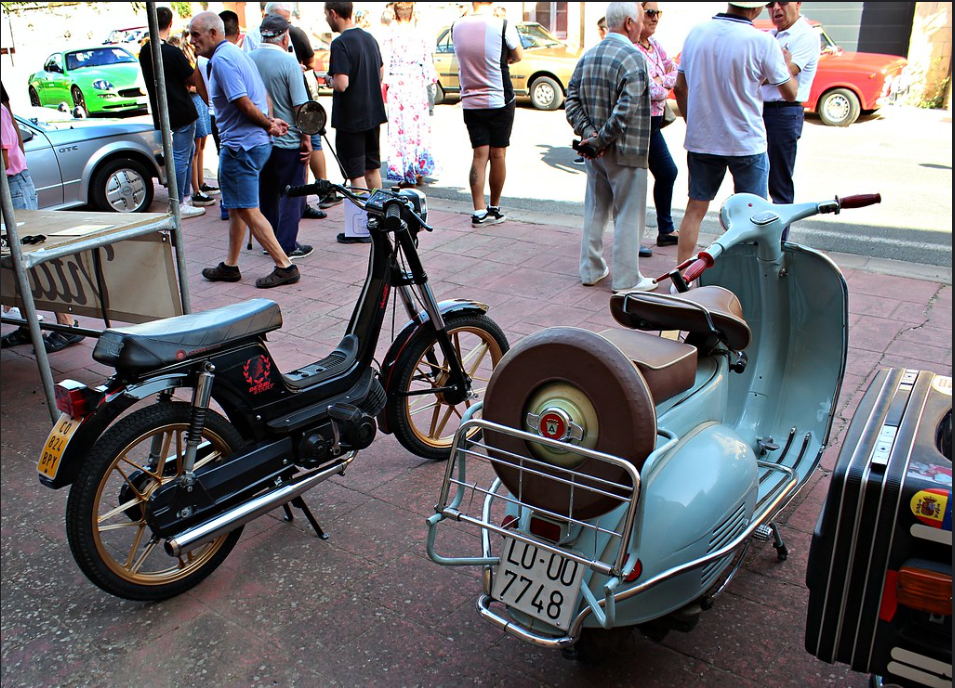Mopeds Unveiled: The Baby Boomer Chronicles
This article explores the role of mopeds in the lives of the baby boomer generation in the 1960s. It discusses how mopeds evolved from practical transportation to symbols of freedom and social expression. The article also highlights the scooter scene of the era, changing perceptions of mopeds, the emergence of sport mopeds, and the impact of the oil crisis on moped usage. Overall, it showcases how the baby boomers shaped the cultural significance of mopeds during their time.
POLITICS 1960'SMOPED CULTURE
12/23/20233 min read


Mopeds Unveiled: The Baby Boomer Chronicles
Introduction
Embark on a captivating journey with "Mopeds Unveiled," where we delve into the colorful tapestry of the 1960s, a defiant generation of baby boomers who revolutionized the essence of mopeds from mere transport to emblems of freedom and social expression. As we venture into the vibrant youth culture of the time, we explore how mopeds became integral to leisure, courtship, and the revolutionary spirit that defined a generation on the move.
The Baby Boomer Generation
The Baby Boomer generation, born in the aftermath of World War II from 1946 to 1964, stands as an emblematic force that reshaped the course of the western world. As this demographic wave matured, it swelled into a formidable population bubble, influencing every aspect of social dynamics. Characterized by their sheer numbers and the unprecedented economic prosperity of their upbringing, Boomers were catalysts of momentous social transformations. From the revolutionary zest of the 1960s to the economic fluctuations of the 1970s, each period of their collective journey was marked by landmark events — civil rights movements, cultural renaissance, technological advancements, and political changes — signaling their significant footprint on society's evolution. With each stride, the Baby Boomers not only witnessed but actively orchestrated the unfolding narrative of the modern era.
The Sixties Scooter Scene
In the post-war era, mopeds and scooters played distinct roles in the lives of young adults, particularly the baby boomers. Mopeds, initially perceived as practical but lacking in style, were predominantly associated with utilitarian purposes such as commuting to work. In contrast, rebellious young individuals sought alternative means of transportation that exuded flair and individuality. This quest for a distinctive identity led them to embrace scooters, such as the iconic Vespa and Lambretta, or the larger motorcycles of the era. Such was the size of the market; all tastes and subcultures were catered to, with European youth aligning themselves with either the stylish scooter culture or the edgier rocker motorcycle subculture.
Changing Perceptions
As the baby boomers transitioned into early adulthood during the 1960s, a notable transformation occurred in the perception of mopeds. No longer confined to their austere origins, mopeds evolved into symbols of youthful vigor and social mobility. The decade witnessed a lively scene where energetic young adults embodied the spirit of the era. Mopeds transcended their utilitarian function, becoming not just a means of transportation but also tickets to adventure and agents of camaraderie. The landscape was marked by rallies, meet-ups, and moped-centric events, weaving the DNA of leisure into these two-wheeled icons and solidifying their enduring embrace within the cultural fabric of the time.
Sport Mopeds and Social Status
The advent of sport mopeds transformed the landscape of youth transport. These sleek, speedy machines offered more than just mobility; they exemplified an exhilarating lifestyle choice that captivated the imagination of an entire generation. Advertisements from the era depict dashing young men, helmets casually slung over their arms, receiving admiring glances from female peers. This imagery not only accelerated sales but also fueled a narrative — mopeds were now intertwined with attractiveness and coolness, becoming an aspirational accessory associated with the in-crowd and an emergent culture centered around movement, speed, and style.
Mopeds During the Oil Crisis
During the tumultuous 1970s, the global oil crisis sent shockwaves through economies, forcing societies to rethink their relationship with fuel-dependent transportation. Amidst this backdrop of scarcity and soaring fuel prices, the moped emerged as a pragmatic solution for cash-strapped baby boomers. The impact was twofold: an immediate answer to a pressing economic challenge and a reinforcement of the moped's image as an efficient, cost-effective vehicle suited for the times. Baby boomers, accustomed to adapting in a changing world, adopted these motorized steeds not only out of necessity but also as a reaffirmation of their resilience and resourcefulness. As the oil crisis subsided, millions of mopeds were parked in garages, sheds, and basements, later becoming the barn finds for the new millennium and a new generation of moped enthusiasts.
Conclusion
This vivacious generation rode through societal evolution, turning mopeds into icons of autonomy and societal change. The baby boomers were the first generation to embrace the moped, and the resulting culture rippled well beyond their years, leaving a vibrant narrative of freedom, adaptation, and the power of two wheels that would inspire generations to come. As the sun set on the 1970s, the legacy of the baby boomers, with their now abandoned mopeds, was etched into the annals of transport history. Japanese manufacturers had matured, and Yamaha released the first continuously variable transmission (CVT)-equipped scooter, heralding a new era for a new generation. Pedal mopeds were now consigned to history, their pedals needed only for legal compliance. The 1980s loomed large for the 50 cc scooter; this was to be a bountiful time.
